Many homeowners assume that installing a metal roof eliminates the need for traditional gutter systems. After all, metal roofing appears sleek, self-sufficient, and designed to shed water efficiently. However, this common misconception can lead to costly property damage and expensive repairs down the road.
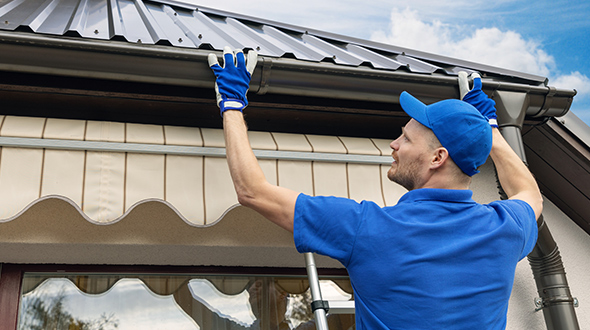
The reality is that metal roofs actually create unique water management challenges, making gutters more essential than ever. Unlike asphalt shingles that gradually absorb and slow water flow, metal surfaces create rapid, concentrated runoff that can overwhelm your property’s natural drainage and cause significant structural damage.
In this comprehensive guide, we’ll explore why gutters remain crucial for metal roofing systems, examine the best materials and installation techniques, and help you make an informed decision that protects your investment for years to come.
Quick Answer: Yes, Gutters Are Essential for Metal Roofs
The consensus among roofing professionals and building science experts is clear: gutters are highly recommended for metal roof installations. This necessity stems from the fundamental physics of how metal roofing handles water compared to traditional roofing materials.
A metal roof’s smooth, impermeable surface causes rainwater and snowmelt to shed at dramatically accelerated rates. While asphalt roofs gradually release water through slower absorption and runoff patterns, metal roofing creates concentrated sheet flow that can deposit large volumes of water in precise locations around your home’s perimeter.
Without gutters to manage this rapid water discharge, your home’s foundation, landscaping, siding, and basement remain vulnerable to water damage. Professional installation ensures that your gutter system can handle the increased water volume and velocity generated by metal roofs during storm events.
The investment in quality gutters for metal roofs pays dividends through prevented damage, reduced maintenance costs, and long-term structural protection that far exceeds the initial installation expense.
Why Metal Roofs Create Unique Water Management Challenges
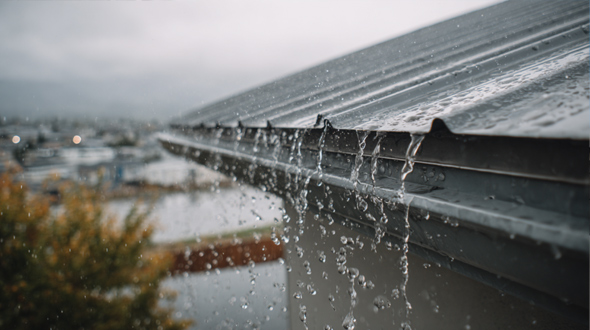
Metal roofing systems present distinct hydrological challenges that differentiate them from traditional roofing materials. Understanding these characteristics helps explain why gutters become even more crucial with the installation of a metal roof.
Accelerated Water Discharge
The smooth surface of steel roof and aluminum panels creates minimal friction, allowing water to travel at much higher speeds than on textured asphalt shingles. This rapid movement concentrates water flow along predictable paths, particularly where standing seam profiles or corrugated designs channel runoff toward roof edges.
Traditional roofing materials, such as wood shakes or composite shingles, naturally slow water movement through their surface texture and absorption. Metal roofing, by contrast, is entirely water resistant and sheds moisture immediately upon contact.
Concentrated Flow Patterns
Metal roofs channel water along seams and valleys, creating concentrated discharge points rather than the distributed runoff pattern typical of other materials. This concentration effect means that specific areas around your home receive dramatically higher water volumes during rain events.
The steep pitches commonly used with metal roofing systems further amplify water velocity, creating powerful sheet flow that can easily overwhelm ground-level drainage and cause severe soil erosion around your home’s foundation.
Thermal Expansion Effects
Metal roofing expands and contracts with temperature changes, which can affect water flow patterns and create additional stress on any attached gutter system. Proper installation must account for these thermal movements to ensure long-term performance and prevent damage to gutters from expansion-related failures.
Consequences of Not Installing Gutters on Metal Roofs
The absence of gutters on metal roofs exposes your property to numerous costly damage scenarios that can far exceed the initial investment in a quality gutter system.
Foundation Damage and Structural Issues
Concentrated water discharge from metal roof edges creates persistent soil saturation around your home’s foundation. This moisture accumulation can cause foundation settling, cracking, and hydrostatic pressure that forces water into basements and crawl spaces.
Foundation repairs typically cost between $10,000 and $25,000, depending on the extent of damage. Basement flooding remediation adds thousands more in water damage restoration, mold prevention, and lost personal property.
The rapid water runoff from metal roofing can create erosion channels that undermine foundation stability over time, leading to structural issues that compromise the integrity of your entire home.
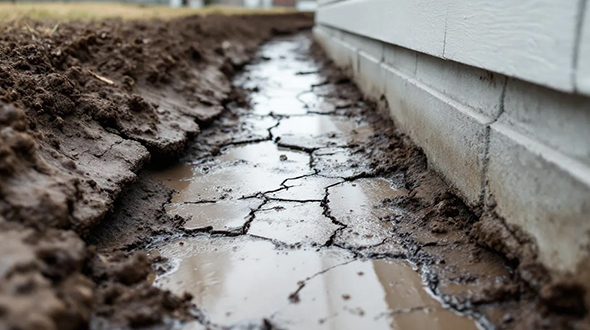
Soil Erosion and Landscaping Destruction
The concentrated water flow from unprotected metal roof edges strips away topsoil, mulch, and plant materials directly beneath the drip line. This erosion destroys carefully planned landscaping and can expose plant roots, killing established vegetation.
Replacing eroded soil and damaged landscaping requires ongoing maintenance costs that quickly accumulate over time. The concentrated water discharge can also create permanent channels and depressions that are difficult and expensive to repair.
Siding and Exterior Wall Damage
Water splashing back from hard surfaces or being driven sideways by wind during heavy rain can saturate and damage your home’s exterior walls. Wood siding, fiber cement, and stucco surfaces are particularly vulnerable to water infiltration and staining.
The high-velocity water discharge from metal roofs increases the force and frequency of water contact with exterior walls, accelerating deterioration and requiring more frequent maintenance or replacement of siding materials.
Water Build Up and Moisture Problems
Without proper drainage, water pooling around your foundation creates persistent moisture problems that can lead to basement flooding, crawl space dampness, and indoor air quality issues. These conditions promote mold growth and create unhealthy living environments.
The rapid water runoff from metal roofs concentrates moisture in areas where your home’s drainage systems may not be designed to handle such volumes, creating ongoing water management challenges.
Best Gutter Materials for Metal Roofing Systems
Selecting appropriate gutter material for metal roof applications requires consideration of the increased water volumes, thermal expansion, and compatibility factors unique to metal roofing installations.
Seamless Aluminum Gutters
Aluminum gutters represent the industry standard for metal roofing applications, offering an optimal balance of performance, durability, and cost effectiveness. Their lightweight construction reduces stress on fascia board attachments while providing excellent corrosion resistance.
Seamless aluminum systems eliminate the leak-prone joints found every 10 feet in sectional installations, creating a more reliable water management system. The custom fabrication ensures a precise fit with your metal roof’s dimensions and overhang specifications.
Professional installation of seamless gutters typically includes 20-year warranties on both materials and workmanship, providing long-term value that justifies the initial investment.
Steel Gutters for Heavy Duty Applications
Steel gutters provide superior strength for large residential or commercial metal roof installations, particularly in areas with exceptionally high water volumes. Galvanized and stainless steel options provide excellent structural integrity for harsh weather conditions.
The additional strength of steel gutters makes them ideal for snow country applications where ice buildup and heavy snow loads can damage weaker gutter materials. However, steel requires careful attention to rust-resistant coatings and proper maintenance to prevent corrosion.
Copper Gutters for Premium Applications
Copper gutters provide the ultimate in durability and aesthetic appeal, with properly installed systems lasting over 50 years. Their natural patina development creates an attractive appearance that complements a wide range of architectural styles.
The premium cost of copper gutters – often three to five times that of aluminum – limits their use primarily to high-end residential projects or historic home renovations where longevity and appearance justify the investment.
Material Compatibility Considerations
When installing gutters on metal roofs, galvanic corrosion between dissimilar metals must be prevented by selecting fasteners and isolation techniques properly. Aluminum gutters on steel roof systems require specialized fasteners or isolating washers to prevent electrochemical reactions.
The thermal expansion rates of different materials must also be matched to prevent stress-related failures as temperatures fluctuate throughout the seasons.
Seamless vs. Sectional Gutters for Metal Roofs
The choice between seamless and sectional gutter systems becomes particularly important for metal roof applications due to the increased water volumes and velocities associated with them.
Seamless Gutter Advantages
Seamless gutters provide superior performance for metal roofing applications by eliminating potential leak points that occur at 10-foot intervals in sectional systems. This continuous construction handles high-velocity water flow more effectively and reduces long-term maintenance requirements.
Custom on-site fabrication ensures that seamless systems precisely match your metal roof’s dimensions and water discharge patterns. This precision installation maximizes water collection efficiency and prevents overflow during heavy rainfall events.
The reduced number of joints and connections in seamless systems also minimizes thermal expansion stress points that can cause leaks or separation over time.
Professional Installation Requirements
Seamless gutters require specialized equipment and professional installation expertise that ensures optimal performance with metal roofing systems. Investing in professional installation provides warranty coverage and ensures that your gutter system will properly handle the unique demands of managing water from a metal roof.
Proper slope calculations, fascia board attachment techniques, and downspout sizing all require professional expertise to achieve optimal results that protect your property investment.
Proper Installation Techniques for Metal Roof Gutters
Installing gutters on metal roofs requires specialized techniques that account for the unique characteristics of metal roofing systems and their water discharge patterns.
Fascia Board Attachment Method
Gutters should be securely attached to the fascia board rather than directly to the metal roofing panels or the roof deck. This attachment method preserves roof warranties while providing stable support for the gutter system under heavy water loads.
Proper fascia board preparation includes ensuring adequate structural support and applying appropriate sealants to prevent water infiltration behind the gutter system. The fascia board attachment also allows for thermal expansion without stressing the metal roofing itself.
Proper Slope and Positioning
Achieving the correct slope of 1/4 inch per 10 feet ensures that collected water flows efficiently toward downspouts without pooling or backflow. This slope must be precisely calculated and maintained throughout the entire gutter run for optimal performance.
Gutter positioning relative to the metal roof edge requires careful adjustment to capture fast-moving water without allowing overflow during peak discharge periods. The smooth surface of metal roofing can cause water to shoot beyond improperly positioned gutters.
Downspout Sizing and Placement
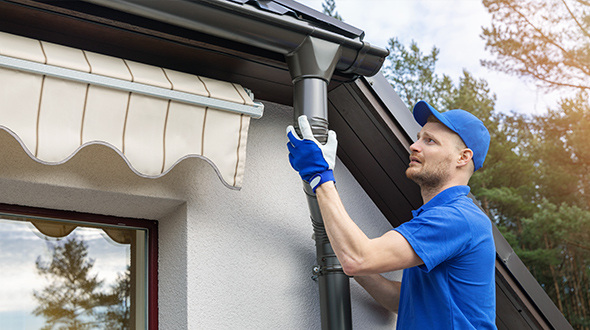
Metal roof installations typically require larger or additional downspouts to handle the increased water volume. At least one 3″ x 4″ downspout is recommended per 20-25 feet of gutter run for larger or steeper metal roofs.
Strategic downspout placement ensures that water is directed away from vulnerable areas while providing adequate capacity during heavy rainfall or rapid snowmelt events.
Compatible Fastener Selection
All fasteners, hangers, and brackets must be compatible with both the gutter material and the metal roofing system to prevent galvanic corrosion. Stainless steel or coated fasteners offer long-term durability, preventing chemical reactions between dissimilar metals.
Proper fastener spacing and load distribution prevent stress concentrations that can cause gutter failure under the dynamic loads created by the water discharge from metal roofs.
Climate-Specific Considerations for Metal Roof Gutters
Different climate conditions create unique challenges for gutter systems on metal roofs, requiring specialized approaches to ensure optimal performance and longevity.
Heavy Rainfall Regions
Areas like the Pacific Northwest, which experience frequent heavy rain, require robust gutter systems with oversized channels and enhanced capacity. Six-inch gutters with multiple downspouts prevent overflow during intense precipitation events, which are common in these regions.
Gutter guards become particularly important in areas with heavy rainfall, as they prevent debris accumulation that can cause clogged gutters and overflow problems during critical storm periods.
Snow and Ice Considerations
Snow country installations require snow guards to prevent large sheets of snow and ice from sliding off metal roofs and damaging gutters. These retention systems protect both the gutter installation and people below from dangerous ice slides.
Installing heating cables in gutter systems can prevent ice dam formation and maintain proper drainage throughout the winter months. This ice dam prevention strategy protects both the roof system and interior spaces from water damage.
Snow retention systems work in conjunction with gutters to manage both liquid runoff and frozen precipitation in a controlled manner, preventing property damage.
Desert and Arid Climates
Even in arid regions, gutters remain essential for managing the intense but infrequent rainfall events that can cause severe erosion and flooding. Metal roofs in desert climates can create dramatic runoff during rare but powerful storms.
The concentrated nature of desert rainfall makes gutters essential for protecting foundations and landscaping during these intense precipitation events, even though they may occur infrequently.
Tropical Climate Requirements
Tropical regions require gutters that can handle sudden, high-volume downpours, which can overwhelm inadequate drainage systems. Large downspouts and enhanced gutter capacity become essential for managing tropical storm runoff.
Corrosion resistance becomes particularly important in tropical climates where high humidity and salt air can accelerate deterioration of gutter materials and fasteners.
Maintenance Requirements for Metal Roof Gutters
Proper maintenance ensures that your metal roof gutter system continues to provide effective water management and protection throughout its service life.
Regular Cleaning Schedules
Clean gutters at least twice a year, once in the spring and once in the fall, to remove accumulated debris that can cause blockages and overflow problems. Metal roofs may deposit fewer granules than asphalt shingles, but wind-blown debris still requires regular removal.
The smooth surface of metal roofing can actually increase the amount of debris that reaches gutters, as nothing is trapped on the roof surface itself. This makes regular cleaning even more important for maintaining proper drainage.
Inspection and Preventive Maintenance
Regular inspections should focus on fastener tightness, joint integrity, and any signs of thermal expansion stress. The movement of metal roofing systems can affect gutter attachments over time, requiring periodic adjustment or reinforcement.
Check downspout connections and extensions to ensure water is directed away from the foundation. Ground settling or landscaping changes can affect drainage patterns and necessitate adjustments to water discharge points.
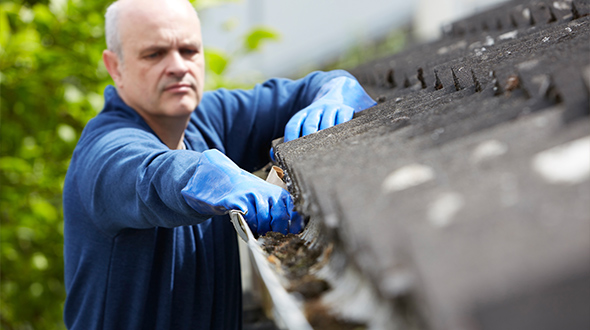
Gutter Guards and Protection Systems
Installing gutter guards significantly reduces maintenance requirements while preventing debris accumulation that can cause clogged gutters. Modern guard systems are designed specifically for the high water volumes generated by metal roofing.
Quality gutter guards pay for themselves through reduced cleaning requirements and the prevention of overflow damage during storm events, as debris-blocked gutters fail to function properly.
Coating and Corrosion Prevention
Apply protective coatings to joints, seams, and fastener locations to prevent corrosion and extend system life. This preventive maintenance is particularly important in coastal or industrial environments where atmospheric conditions accelerate deterioration.
Regular maintenance of protective finishes ensures that your gutter investment continues to provide reliable performance throughout its designed service life.
Cost Analysis: Investment vs. Protection
Understanding the economic relationship between gutter installation costs and potential damage prevention helps homeowners make informed decisions about their metal roof water management systems.
Installation Cost Ranges
Professional gutter installation for metal roofs in Atlanta typically ranges from $1,500 to $3,500 for average residential applications, depending on linear footage, material selection, and roof complexity. Seamless aluminum gutters offer the best balance of performance and cost effectiveness for most applications.
Premium materials, such as copper gutters, can significantly increase costs but provide enhanced durability and aesthetic appeal that may justify the investment for certain applications.
Damage Prevention Value
Foundation repairs without proper water management can easily cost $10,000 to $25,000, not including additional expenses for basement waterproofing, mold remediation, and interior restoration. Preventing just one significant water intrusion event justifies the gutter investment multiple times over.
The concentrated water discharge from metal roofs increases the likelihood and potential severity of damage, making the value proposition of investing in quality gutters even more compelling.
Long-term Return on Investment
High-quality gutter systems, when properly installed, typically provide 20 years or more of reliable service with minimal maintenance requirements. This longevity, combined with the prevention of damage costs, creates a compelling return on investment that far exceeds that of most other home improvement projects.
The energy efficiency benefits of preventing water damage and maintaining structural integrity also contribute to the long-term value of the home, as well as reduced maintenance costs over the property’s lifespan.
Professional Installation Value
While DIY sectional gutters may appear less expensive initially, professional installation of seamless systems provides warranty coverage, optimal performance, and long-term reliability that justifies the additional investment.
Professional installation ensures that gutter systems are properly sized, positioned, and integrated with your metal roofing system for maximum effectiveness and longevity.
Alternatives to Traditional Gutters (Limited Effectiveness)
While various alternatives to conventional gutter systems exist, none provide the comprehensive water management capabilities required for metal roof applications.
Rain Chains and Decorative Options
Rain chains offer aesthetic appeal and can slow water descent, but they lack the capacity to handle the high-volume, high-velocity discharge typical of metal roofs. They work best as decorative supplements to traditional gutters rather than replacements.
The concentrated flow from metal roofing can overwhelm rain chains, causing splashing and soil erosion that defeats their intended purpose.
Ground-Level Solutions
Splash blocks provide only immediate point protection and cannot address the broader water management challenges created by metal roof runoff. French drains require extensive excavation and are costly, yet they often fail to protect siding and exterior walls from water contact.
Ground-level solutions also cannot prevent the ice dam formation and roof-level water management issues that properly installed gutters address.
Landscaping and Grading Approaches
While proper grading and landscaping can help manage water once it reaches the ground, these solutions cannot match the comprehensive protection provided by intercepting water at the roof edge through a quality gutter system.
The rapid discharge and large volumes from metal roofs often overwhelm landscape-based drainage solutions, making gutters the primary line of defense against water damage.
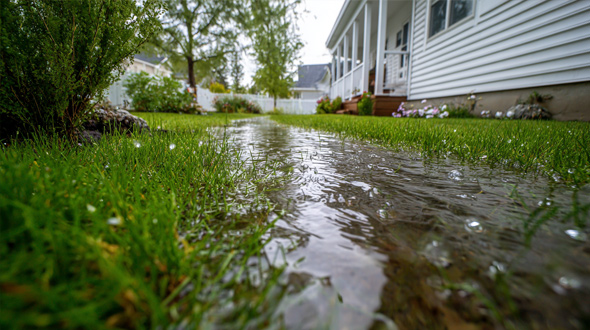
Expert Recommendations and Industry Standards
Leading metal roofing manufacturers, professional roofing contractors, and building science organizations consistently recommend integrated gutter systems for metal roof installations.
Manufacturer Guidelines
Major metal roofing manufacturers include gutter recommendations in their installation guidelines and warranty requirements. Proper water management through quality gutters is often a key component in maintaining warranty coverage for metal roofing systems.
The industry consensus recognizes that even the highest quality metal roofing requires complementary water management systems to provide comprehensive property protection.
Building Code Considerations
Many regional building codes now include specific gutter requirements for certain roofing types or local climate conditions. These regulations reflect growing recognition of the importance of water management in building design and property protection.
Insurance companies are increasingly viewing proper gutter installation as a risk mitigation measure, potentially offering premium discounts for homes with professionally installed, adequately sized gutter systems.
Professional Roofing Standards
Roofing professionals consistently emphasize that metal roof installation should include comprehensive water management planning that addresses both roof performance and perimeter protection through the use of appropriate gutters.
The integration of roofing systems and gutter design ensures optimal performance and long-term property protection that justifies the combined investment.
Metal Roof and Gutter Conclusion
The question of whether you need gutters with a metal roof has a clear, evidence-based answer: absolutely yes. The unique water management challenges created by metal roofing make gutters more essential than ever, not less.
Metal roofs shed water more quickly and in greater quantities than traditional roofing materials, creating powerful runoff that can cause severe foundation damage, soil erosion, and structural problems without proper management. The smooth, water-resistant surface that makes metal roofing so effective also makes it imperative to control where the water goes after it leaves your roof.
Investing in quality gutters, particularly seamless aluminum systems with professional installation, provides comprehensive protection that far exceeds the initial cost. With foundation repairs potentially costing $10,000 to $25,000 or more, proper gutters represent one of the most cost-effective insurance policies you can purchase for your home.
Whether you’re planning a new metal roof installation or already have metal roofing without gutters, directing water away from your foundation and protecting your property should be a top priority. The physics of water management make gutters a crucial component of any comprehensive metal roofing system.
Don’t let the sleek appearance of your metal roof fool you into thinking gutters are unnecessary. Contact a roofing professional today to assess your water management needs and get a free estimate for the right gutters to protect your metal roof investment for decades to come.
(404) 220-9288